Gardening in Waimea: Matilda Tompson produces a bounty of vegetables, herbs and flowers
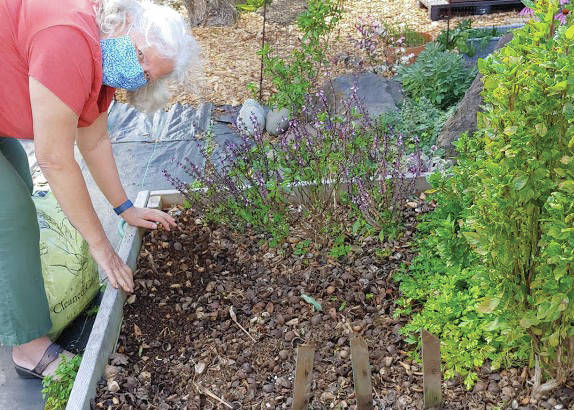
Matilda clears and cleans her beds before her seasonal replanting. (Diana Duff/Special to West Hawaii Today)
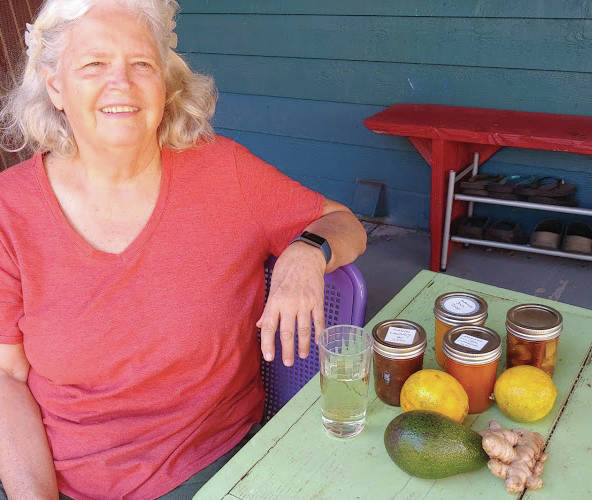
Matilda often enjoys her own grown herbal tea at the end of a work day in the garden. (Diana Duff/Special to West Hawaii Today)
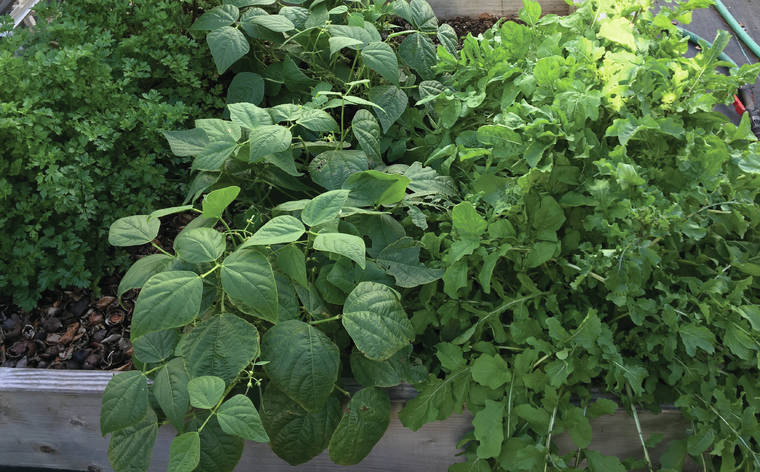
Just a few months after planting, Matilda can enjoy food from her garden. (Matilda Tompson/Special to West Hawaii Today)
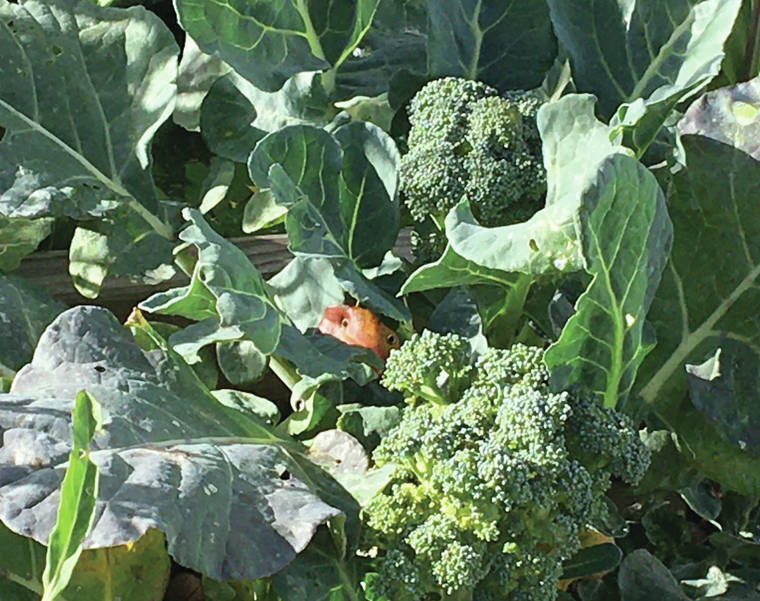
Matilda’s garden is filled with healthy plants and good food. (Matilda Tompson/Special to West Hawaii Today)
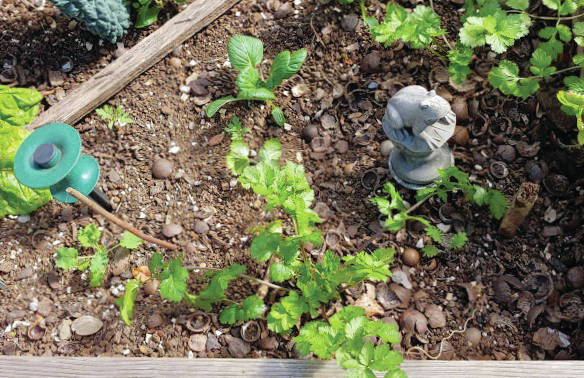
Keeping cats out of a garden requires lots of obstacles. (Diana Duff/Special to West Hawaii Today)
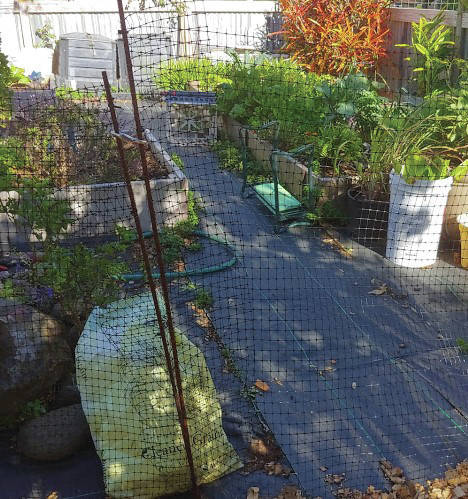
A light fence seems to be enough to discourage chickens from entering the garden. (Diana Duff/Special to West Hawaii Today)
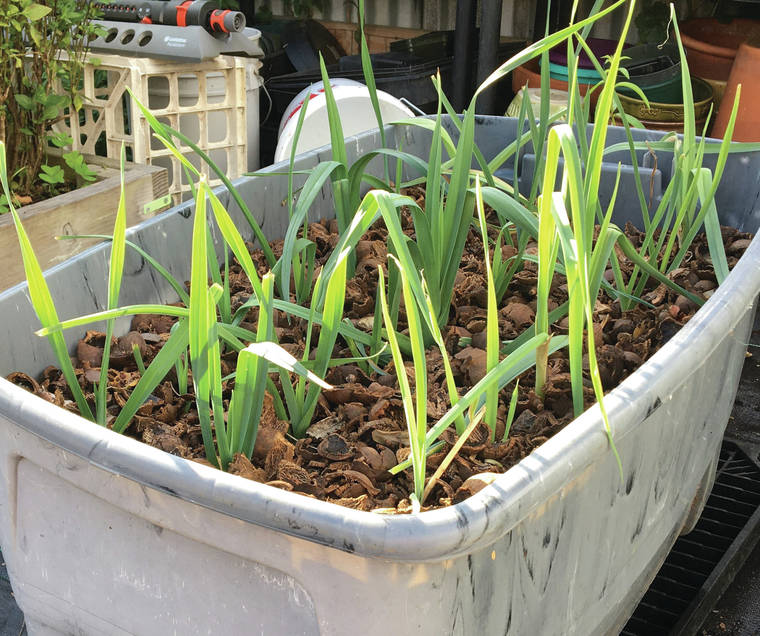
With limited garden space, Matilda decided to plant her leeks in a plastic tub. (Matilda Tompson/Special to West Hawaii Today)
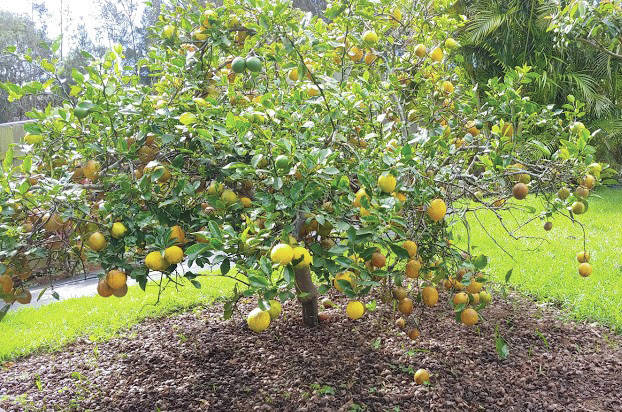
Mulching citrus trees keeps down weeds and feeds the soil making a bounteous harvest likely. (Diana Duff/Special to West Hawaii Today)
Matilda Tompson was likely born with a green thumb. As a child, she delighted in visits to her grandparent’s farm in Massachusetts. At home in Delaware, she would scour the woods near her house for pretty flowers, dig up the plant and bring it home. Her dad was growing vegetables like lettuce, green beans and tomatoes. He was not always delighted with the addition of weeds from the woods to his garden. That did not discourage Matilda.
Matilda Tompson was likely born with a green thumb. As a child, she delighted in visits to her grandparent’s farm in Massachusetts. At home in Delaware, she would scour the woods near her house for pretty flowers, dig up the plant and bring it home. Her dad was growing vegetables like lettuce, green beans and tomatoes. He was not always delighted with the addition of weeds from the woods to his garden. That did not discourage Matilda.
She continued to garden everywhere she landed. While working as a potter at her home in southeastern Pennsylvania, Matilda’s garden was a place for her to relax while producing tasty edibles for herself and her friends.
In 1981, she came to Hawaii to visit a friend. She describes her arrival saying, “I felt like I had come home.”
She soon moved onto a commercial ginger farm in Honaunau and began a quick course in tropical plants. Chayote, ulu, pomelo and jackfruit were some of her new acquaintances that inspired new recipes and some tasty results. She expanded the veggie garden on the farm and added lots of herbs she had grown in the past.
She added to her tropical gardening repertoire when she worked on cacao and coffee farms in Colombia and Ecuador and visited the beautiful gardens in Bali. She returned to Honaunau ready be a tropical gardener but still knew she had a lot to learn. She moved onto a working farm just below the highway on the road to Pu’u Honua where she built a small structure and became a garden helper.
“That’s where being a tropical gardener became a reality,” Matilda says. “I learned so much in my years on that Honaunau farm.”
Looking back, she laughs and talks about living in a cacophonous jungle. She had built her living space under two large mango trees. Mango season meant many loud bangs as the fruit hit her roof. Night sounds got intense when the pigs discovered the fallen mangos, especially when they ate fermented ones and became rowdy drunks. Add to that, adult myna birds gathered every evening in the mangos to hold raucous gossip sessions, and the younger birds decided that 3 a.m. was time to start the day.
When she was offered a job at the West Hawaii Mediation Center in Waimea, she decided to move to higher ground and take up residence in Waimea. Again, Matilda put in a garden everywhere she lived until she finally decided to buy a home and put in a permanent garden of her own. For the last 20 years, she has been growing lots of food and flowers at her house on the rainy side of Waimea town.
When asked what the difference was between gardening in wet side Waimea and lower Honaunau her response was 2,000 feet higher, 20 degrees colder and somewhat wetter. The good news was that she actually had soil instead of rocks on her property in Waimea.
Shortly after moving into her new home, Matilda started planting and playing. She put in a retaining wall to level her front yard and put corrugated metal fencing around the perimeter to make it more private. Once she had a level planting area, she put in raised beds and enhanced the existent medium by collecting good soil and amendments from around town.
“I always had buckets in the back of my car,” she explained. “Whenever I saw topsoil being piled up on construction sites, I’d ask for some. If I saw piles of leaves, manure or wood chips on a site, I would, with permission, collect it for my garden.”
I asked Matilda if she thought gardening was a passion for her. She hesitated a minute then replied that it was a need, something she was compelled to do as a pleasurable meditation and grounding experience. Her love of gardening was fulfilled when, for once, her actual job matched her passion. Though she was always involved at Mala’ai Gardens at the Waimea Middle School, her two-year stint as their executive director was a perfect match for her.
Today, she attends to her garden daily. She mulches around her plants and augments her soil with whatever she thinks the plants need. She regularly adds compost and occasionally buys organic fertilizer or other OMRI certified additives including bat guano, blood meal and bone meal. She describes her process saying she waits to see what the plants want. That might qualify Matilda as a true plant whisperer.
Whatever she is doing, it is dramatically successful. Her gardens are thriving with a bounty of vegetables, herbs and flowers that she uses daily. What she doesn’t eat straight from the garden, she gifts to friends, freezes or preserves for future use.
The day in January that I visited Matilda, we sat down to sip some wonderful lemon verbena tea while she showed me her latest canning projects. Gifted with a bumper crop of mangoes from a friend, she had made mango jam and mango chutney. She’d also made a wonderful citrus marmalade that sat on the table with her turmeric, Meyer lemon and avocado harvest that would be part of an upcoming meal.
That winter day she was preparing a bed for spring veggies. Recently, she sent me a photo of that bed which is now overflowing with basil, parsley, beans and arugula. Another photo of her hearty broccoli crop further convinced me that Matilda certainly communicates well with her plants.
The often cold and damp conditions in her garden mean that seeds sometimes struggle to germinate and grow. Of the few plants she starts from seed, her absolute favorite is the Gold Rush bush beans from Botanical Interest. In addition to growing plants from seed, she also buys seedlings from local growers like Kari Hagerman, Sandy and Everett Pang and the Ouli Plants booth at the Saturday Pukalani Stables Farmer’s Market. Occasionally, she does some propagating from cuttings and sometimes she sees the results of unplanned hybridizing growing in her garden.
She reported that her bok choy seems to have crossed with a kailan resulting in what Matilda calls her “hanky panky” bok choy. More open and with purple stems, she says the new hybrid is very tasty. She’s anxious to see what she gets from the next generation of seeds.
Matilda’s garden is living proof of the adage that says insects and diseases do not attack healthy plants. The plant diversity in her beds is also a good deterrent to insects and diseases. She reported occasional rounds of aphids and very little disease. She treats damaging insects early with Safer soap and neem oil. After seeing zucchini and tomato plants suffer from powdery mildew, she decided those plants were not well suited to her site. So, she doesn’t grow them anymore.
When asked about her gardening challenges in Waimea’s wet side she quickly responded that the snail population can grow exponentially in her yard. Also, rats have munched her sweet potatoes underground and she needs a light fence to discourage stray chickens from eating her seedlings or her greens. She also places obstacles to keep cats from considering her raised beds litter boxes.
Her current bounty includes lots of different greens and herbs as well as broccoli, beans and bunching onions. She’s also growing leeks and shallots from Dixondale Farms in repurposed plastic tubs.
When asked, Matilda had a few words of advice for aspiring gardeners. She replied, “Grow what you like to eat, and have fun doing it.”
She added that it is important to pay attention to your plants. They notice. When you enjoy gardening, the joy you bring to the task is repaid in spades by your happy and highly productive plants.
Diana Duff is a plant adviser, educator and consultant living part time in Kailua-Kona.
^
Gardening Events
Every Saturday: “Work Day at Amy Greenwell Garden” from 9 a.m. to 12:30 p.m. Meet at the Garden Visitor Center across from the Manago Hotel in Captain Cook. Come with a mask and be prepared to practice social distancing. Volunteers can help with garden maintenance and are invited to bring a brown bag lunch. Water and snacks provided. Call Peter at 323-3318 for more information.
Available online: “Brochure on Hawaii Leaf Rust” available at HawaiiCoffeeEd.com/CLRtrifold or by contacting Andrea Kawabata by e-mail at andreak@hawaii.edu, by text at 415-694-1511
or phone at 808-322-4892.
“Video on Little Fire Ants” with new information from the Hawaii Ant Lab and Hawaii Tropical Fruit Growers at https://www.htfg.org/post/learn-about-little-fire-ants
Save the Date: “Coffee Berry Borer & Coffee Leaf Rust Conference 2021” on Friday, April 16 & Saturday, April 17 from 9 am to 12:30 pm on Zoom
Registration is at: https://cbb-clr2021.eventbrite.com
Farmer Direct Markets (check websites for the latest hours and online markets)
Wednesday: “Ho’oulu Farmers Market” at Sheraton Kona Resort & Spa at Keauhou Bay
Saturday: “Keauhou Farmers Market” 8 a.m. to noon at Keauhou Shopping Center
Information on their online market at keauhoufarmersmThursarket.com/onlinemarket
“Kamuela Farmer’s Market” 7:30 a.m. to noon at Pukalani Stables
“Waimea Town Market” 7:30 a.m. to noon at the Parker School in central Waimea
“Waimea Homestead Farmers Market” from 7:30 a.m. to noon at the Waimea middle and elementary school playground
Sunday: “Pure Kona Green Market” 9 a.m. to 2 p.m. at Amy Greenwell Garden in Captain Cook
“Hamakua Harvest” 9 a.m. to 2 p.m. at Highway 19 and Mamane Street in Honoka’a
Plant Advice Lines
Anytime: konamg@ctahr.hawaii.edu Tuesdays and Thursdays: 9 a.m. to noon at UH-CES in Kainaliu — 322-4893 or walk in Monday, Tuesday and Friday: 9 a.m. to noon at UH CES at Komohana in Hilo 981-5199 or himga@hawaii.edu


